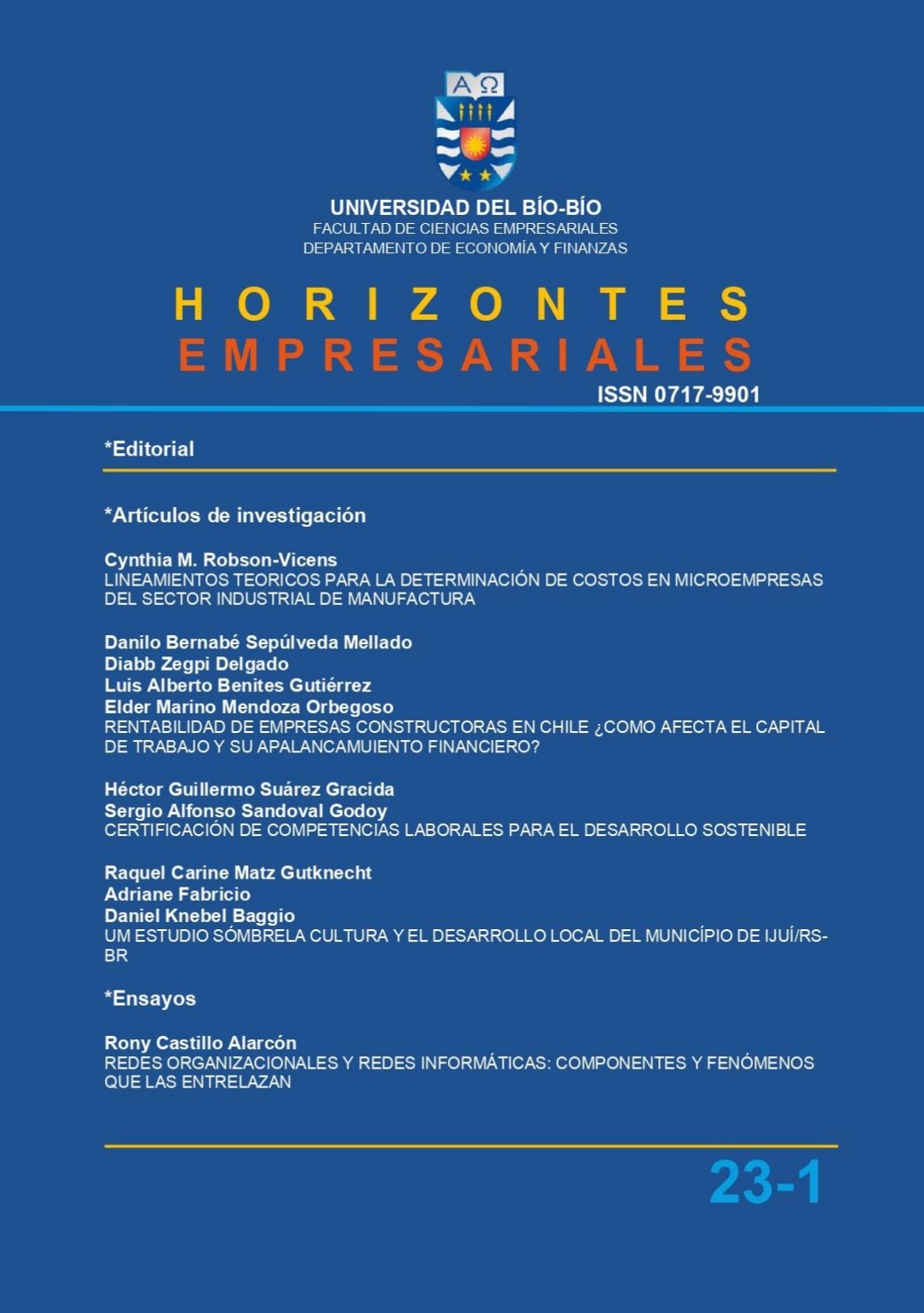Redes organizacionales y redes informáticas: Componentes y fenómenos que las entrelazan
DOI:
https://doi.org/10.22320/hem.v23i1.6625Palabras clave:
Redes Organizacionales, Redes Informáticas, Arquitectura de Red, ClustersResumen
Este ensayo realiza una revisión bibliográfica en el campo de la investigación seminal de las Redes Organizacionales, a través de una analogía conceptual e instrumental empleando un análisis de integración de MaccInnis. En su desarrollo se identificaron siete distintos componentes propios de las Redes organizacionales y fenómenos vinculatorios con las Redes computacionales. Acotando las configuraciones específicas de cada Red, es posible plantear una afinidad entre los elementos de la arquitectura informática y el campo de estudio de las Redes Organizacionales para apoyar la comprensión de estas últimas y de esta forma contribuir tanto al fortalecimiento de su investigación académica como en la evaluación de sus implicancias para el desempeño del mundo empresarial en entornos actuales de creciente complejidad y competitividad.
Citas
Ahuja, G., Soda, G., & Zaheer, A. (2012). The genesis and dynamics of organizational networks. Organization Science, 23(2), 434-448.
Baum, J. A. C., T. J. Rowley, eds. (2008). Introduction: Evolving webs in network economies. Network Strategy: Advances in Strategic Management, Vol. 25. JAI Press, Greenwich, CT, xiii–xxxii.
Belk, Russell W. (1988), “Possessions and the Extended Self,” Journal of Consumer Research, 15 (September), 139–69.
Blau, P. M. (1977). Inequality and heterogeneity. New York: Free Press.
Brass D. J., Galaskiewicz J., Greve H. R., Tsai W. (2004) Taking stock of networks and organizations: A multilevel perspective. Acad. Management J. 47(6) 795–817.
Burt, R.S. (1992). Structural holes: The social structure of competition. Cambridge, MA: Harvard University Press.
DiMaggio, P. (1997). Culture and cognition. Annual Review of Sociology, 22, 263–287.
Emirbayer, M., & Goodwin, J. (1994). Network analysis, culture, and the problem of agency. American Journal of Sociology, 99, 1411–1454.
Gomes-Casseres, B. (1994). Group vs. group: How alliance networks compete. Harvard Bus. Rev. 72(4) 62–74.
Granovetter, Mark S. (1973). “The Strength of Weak Ties.” American Journal of Sociology, 78: 1360-1380.
Gulati, R., Nohria, N., & Zaheer, A. (2000). Strategic networks. Strategic Management Journal, 21, 203–215.
Ibarra, H. (1992). Homophily and differential returns: Sex differences in network structure and access in an advertising firm. Administrative
Ibarra, H., Kilduff, M., & Tsai, W. (2005). Zooming in and out: Connecting individuals and collectivities at the frontiers of organizational network research. Organization Science, 16, 359–371.
Jackson, M. O. (2008). Social and Economic Networks. Princeton University Press, Princeton, NJ.
Jackson, M. O., B. W. Rogers. (2007). Meeting strangers and friends of friends: How random are social networks? Amer. Econom. Rev. 97(3) 890–915.
Kanter, R. M. (1977). Men and women of the corporation. New York: Basic Books.
Kilduff M., Brass D. J. (2010) Organizational social network research: Core ideas and key debates. Acad. Management Ann. 4 317–357
Kiran y Agrawal (2008). Concurrent Design of a Computer Network. Birla Institute of Technology India.
Korte Charles y Stanley Milgram, (1970), Acquintance networks and distance Group, journal of Persoality.
Krackhardt, D. (1990). Assessing the political landscape: Structure, cognition, and power in organizations. Administrative Science Quarterly, 35, 342–369.
Larson, A. (1992). Network dyads in entrepreneurial settings: A study of the governance of exchange processes. Administrative Science Quarterly, 37, 76–104. MacInnis, D. J. (2011). A framework for conceptual contributions in marketing. Journal of Marketing, 75(4), 136-154.
Madhavan, R., B. R. Koka, J. E. Prescott. (1998). Networks in transition: How industry events (re)shape interfirm relationships. Strategic Management J. 19(5) 439–459. 19
Mouw, T. (2006). Estimating the causal effect of social capital: A review of recent research. Annual Rev. Sociol. 32 79–102.
Ostrom, E. (1990). Governing the commons: The evolution of institutions for collective action. New York: Cambridge University Press.
Petty, Richard E. and John T. Cacioppo (1986), Communication and Persuasion: Central and Peripheral Routes to Attitude Change. New York: Springer-Verlag.
Podolny, J.M. (1998). Network forms of organization. Annual Review of Sociology, 24, 57–76.
Raab, J., & Milward, H. B. (2003). Dark networks as problems. Journal of Public Administration Research and Theory
Ramió, C. (1999). Teoría de la organización y administración pública. Tecnos.
Rivera, M. T., S. B. Soderstrom, B. Uzzi. (2010). Dynamics of dyads in social networks: Assortative, relational, and proximity mechanisms. Annual Rev. Sociol. 36 91–115.
Salancik, G.R. (1995). "Wanted: A good network theory of organization." Adminstrative Science Quarterly, 40: 345-349.
Soda, G., Usai, A., & Zaheer, A. (2004). Network memory: The influence of past and current networks on performance. Academy of Management Journal, 47, 893–906.
Tanenbaum, Andrew S. (2003). Redes de computadoras (4ª edición). Pearson Educación. ISBN 9789702601623.
Üstüner, T., & Godes, D. (2006). Better sales networks. Harvard Business Review, 84(7/8), 102-112.
White, H. (1992). Agency as control in formal networks. N. Nohria, R. G. Eccles, eds. Networks and Organizations: Structure, Form, and Action. Harvard Business School Press, Cambridge, MA, 92–117




